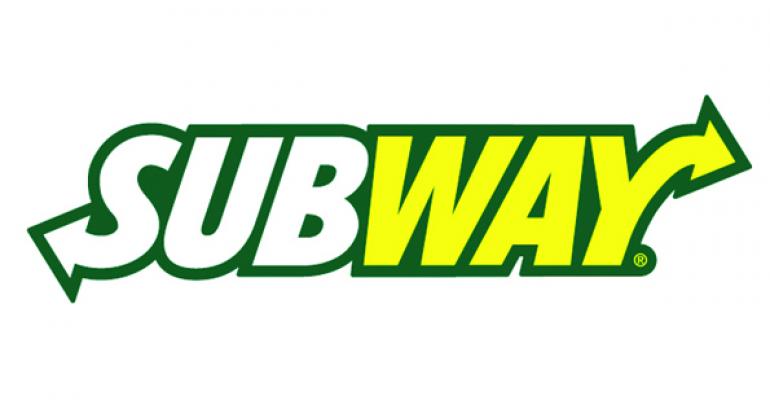Subway TV & Radio, an audio and video package supporting in-restaurant sales and marketing messages, is now in place at about 1,000 U.S. Subway locations and may soon move overseas, according to chain and vendor representatives.
A digital signage network, Subway TV & Radio uses an in-restaurant media player and 40-inch, high-definition flat-screen display viewable by customers as they order. The network displays videos, images and Internet-streamed music and marketing messages.
“With digital signage, we are building a viable, cost-effective program to help our franchisees reach their customers with timely product and promotional messages that influence customer behavior at the counter and increase sales,” said Dennis Clabby, vice president of purchasing for Independent Purchasing Cooperative Inc., a Subway franchisee owned purchasing organization.
“Designed to increase store profitability, the strong positive response of the franchisees and the rapid growth of this program is very encouraging,” he said in a statement.
Officials of Doctor’s Associates Inc., the parent to the 36,000-unit Milford, Conn.-based Subway, said they had no comments about the system or its operation beyond those in the statement.
In its mission to increase sales and profits with nearly all promotional content, Subway TV & Radio differs from the McDonald’s Channel in-restaurant video network slated to be installed in about 650 company and franchisee-operated locations in Southern and Central California.
Watch Subway’s in-restaurant programming; story continues below
According to McDonald’s Channel developers, McDonald’s will offer up about 90 seconds of directly promotional content and the chain’s advertising partners will get about eight minutes of brand messaging during each hour of programming. The content includes general news and entertainment features, localized information and behind-the-scenes looks at McDonald’s.
Though the McDonald’s Channel is a work in progress, the Oak Brook, Ill.-based chain completed a rollout of digital menu and promotion boards for the McCafe beverage program to about 12,600 of the chain’s domestic locations in early 2011.
Bakery-cafe operator and franchisor Tim Hortons Inc. of Oakville, Ontario, in October said it will add digital menu boards to more than 2,700 locations in Canada, or about 80 percent of its system there, by the end of 2012. The chain has long had digital promotions boards, with brand and community news, in most if not all of its Canadian restaurants.
That makes the emerging Subway digital content network among the larger deployments of its kind within foodservice. Independent analyst Nikki Baird, a managing partner with Retail Systems Research, has some ideas about why the initiative is catching on with the chain’s franchisees.
“They made sure that the benefits weren’t in the strategic realm of ‘branding’ but in the real tactics of results that a franchise owner could get behind,” Baird said.
Based on a briefing she was given about the system, Baird said she believed Subway did itself a favor by doing thorough initial testing at about 50 locations to better understand “what to promote, when to promote and how use might vary by store and by daypart.”
Baird’s company provides market intelligence on retailers’ attitudes and intentions around technology and the strategies it enables.
She said her observations of industries outside of foodservice suggest that successful efforts to convince franchisees to deploy digital signage have at least two characteristics in common.
“The ROI has to be something the franchisee sees; in other words, it has to help them sell more stuff,” she said. “And it has to provide for both corporate-controlled branded communications as well as a relatively high degree of local control or customization of that content.”
Subway said the programming content is supplied and managed at a national level, but that franchisees can influence what is played by logging on and scheduling changes through a franchisee portal. The network allows for local control of playlists across several time slots, such as breakfast, lunch or dinner, it said.
Such customization is important, said Tony Pace, senior vice president and chief marketing officer of the Subway Franchisee Advertising Fund.
“Given the size and scope of our business, our marketing emphasis is not on having a singular message during one particular point of time,” Pace said. “We’re selling sandwiches all day long to over 30 million customers per week.”
Pace credited Real Digital Media, the developer of the Neocast digital signage platform being used by Subway, with helping the chain “extend content placement functions to thousands of local users without relinquishing centralized control.”
For its program, Subway is using Samsung commercial grade displays and Nexcom fanless Z-Player video and audio media players.
Integration of Subway TV & Radio into 500 or so Subway restaurants in the Los Angeles market was rapid, said Bob Grewal, franchisee and Los Angeles area development agent.
“We are confident that the addition of digital signage will enable us to better communicate with our diverse customers and drive future growth,” he said.
The basic hardware, software license and installation package recently was running about $1,999–$1,799 if a smaller 32-inch display was substituted — excluding any additional custom messaging or electrical, Internet or audio cabling installation or service that may be needed, a website for Subway franchisees indicated.
Subway franchisees have the option of upgrading from royalty-free “Subway Radio Basic” content to a $299-a-year program of premium music programming, including such theme packages as “Pop Mix,” “Route 66,” “Spice Latin” and “Jazz Café.”
Contact Alan J. Liddle at [email protected].
Follow him on Twitter: @AJ_NRN




